Black and red butterflies impress with contrasting colors. The combination of black and red is mostly specific to the dorsal wings but it can also be seen on the ventral side in many species.
You can find black and red butterflies all around the world, particularly in South America, Central America, Europe, Africa, Asia, and North America.
These colorful butterflies are known to prefer woodlands, riparian zones, tropical zones, and areas with sufficient warmth and humidity.
They often consume nectar from flowering plants. Some black and red butterflies consume nutrient-rich moisture from species such as nettles.
The color of butterflies doesn’t impact species but black and red butterflies have medium to large sizes. With many species, the wingspan can measure at least 30mm and reach a maximum length of up to 70mm.
Black and red butterflies are also seen in Northern America, mainly in the extreme South of various states as these butterflies often prefer warm tropical climates.
Most butterflies of these colors also have additional colors in the form of dots, eyespots, stripes, or bands. They can cover both the wings and the body.
The following species of butterflies are most common around the world. Black and red colors dominate their appearance.
Table of Contents
1. Red-bordered Pixie
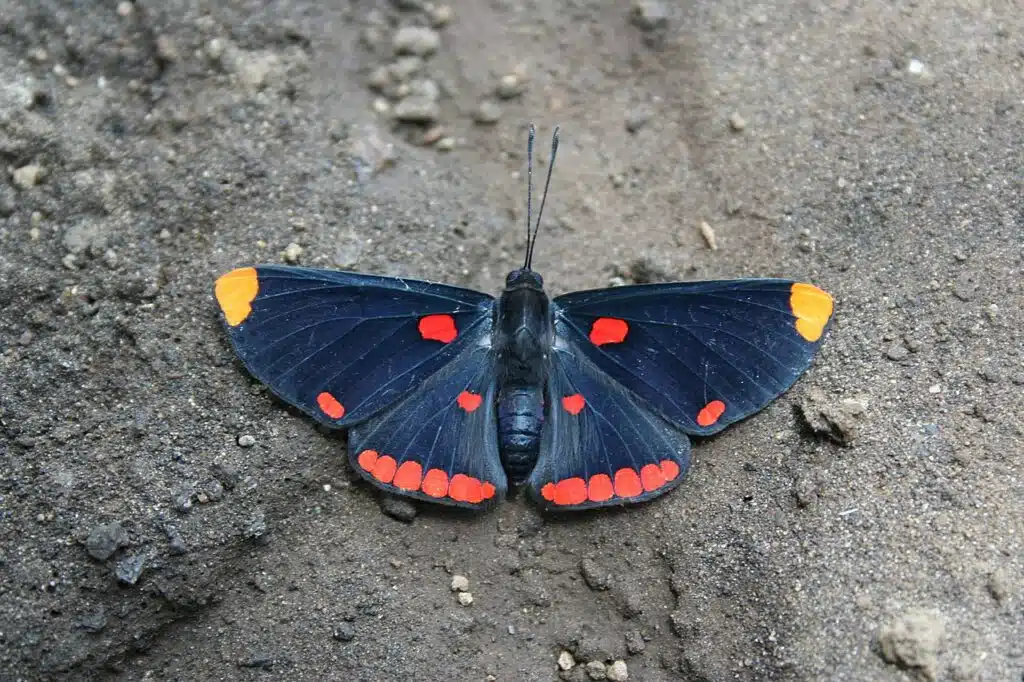
Red-bordered Pixie butterflies (Melanis pixe) are only seen in Southern Texas. These contrasting butterflies have a base black color with red borders on the forewings and red spots on the hindwings.
Orange borders are further distinguishable across its wings.
Red-bordered Pixie butterflies have a short wingspan. Its length varies from 1.1 to 1.4 inches.
Its body and the rest of the wings are black ventrally and dorsally.
This species has a long season being active until late fall. Blackbeads are among its most common plant hosts.
Red-bordered Pixie butterflies are also seen on other host plants including citruses.
2. Snowberry Checkerspot
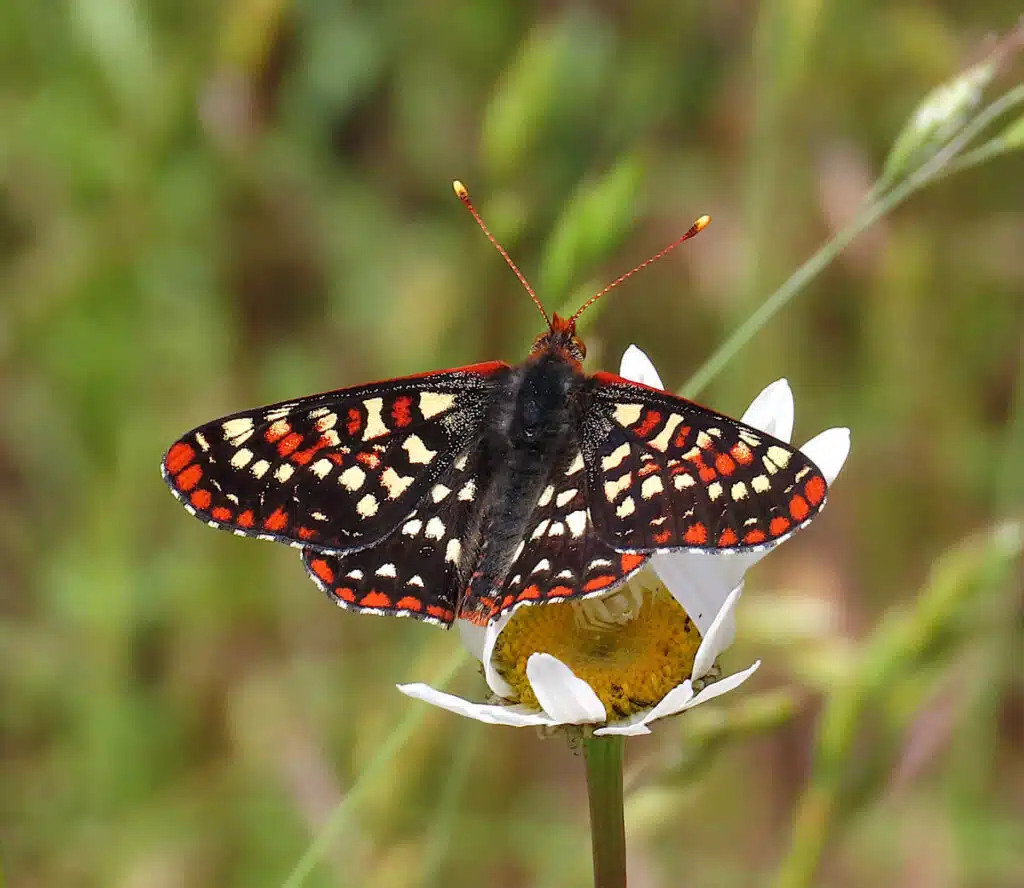
Like all Checkerspots, Snowberry Checherspots (Euphydryas colon) have a colorful appearance.
These butterflies are dominated by black base wing colors. Red dots are seen on its forewings as well as across the margins of the wings.
This species also has an uninterrupted red border across the upper side of its forewings.
Its antennae have a contrasting yellow-red color.
This species also has multiple white dots across its forewings and its hindwings.
As its name implies, the Snowberry Checkerspot is a species that uses snowberry as a host. Honeysuckle is another common host for the species.
You can find the butterfly at high elevations as well as on vegetation next to water sources.
3. Ruby-spotted Swallowtail
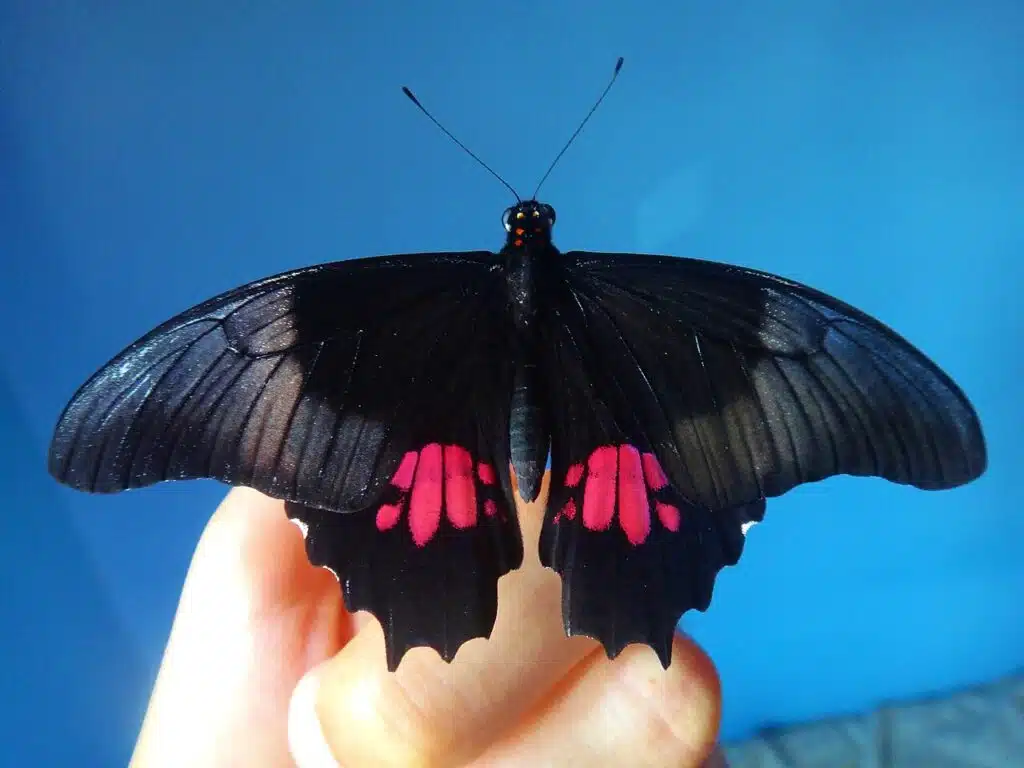
Ruby-spotted Swallowtails (Papilio anchisiades) are black, red, and faded red butterflies native to the US. They live in Southern Texas in the US.
Outside of the country, their range expands to Argentina.
Black is the main color of the wings with red spots on the lower hindwings. Some of the red spots are washed off.
This species has a varying wingspan that rarely measures more than 2.5 inches.
Ruby-spotted Swallowtails first appear in May and they continue being active until October.
The best place to see these black and red butterflies is on its host plant which is one of the multiple citruses in the Southern habitats.
4. Red Postman
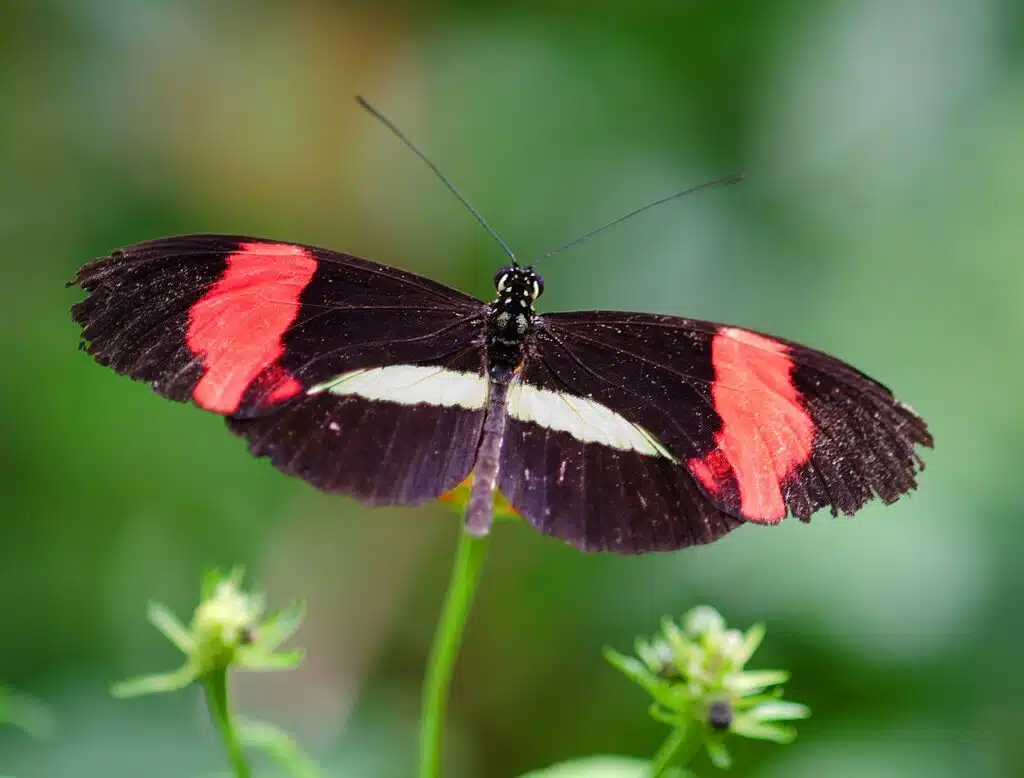
Red Postman butterflies (Heliconius erato) are also known as Small Postman. This species has a black base coloring with red and white sections across the wings but not across the body.
There are 2 large red vertical bands across the wings of the species. A long wide white band is also seen across the wings.
These bands aren’t visible on its black body which only shows a few small white dots.
Butterflies of this species are known to roost or live together on their host plants.
Adult Red Postman feeds on plant pollen on their own during the day but returns to a communal host at night.
Lantana flowers are the most common host for the adult Red Postman.
Communal living has been known to protect the species from common predators such as birds and lizards.
5. Red Rim
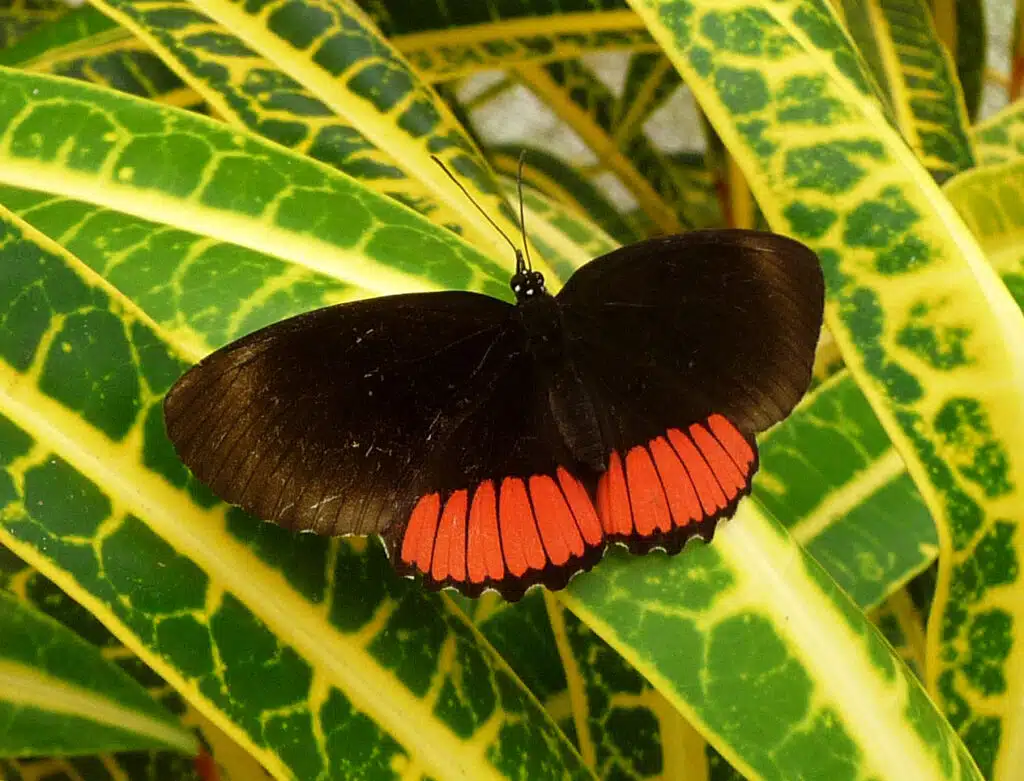
Red Rim butterflies (Biblis hyperia) are typically tied to plants living in tropical climates.
As a result, they are mostly seen across Southern parts of North America.
The species has black base coloring with just a small red section. Red bands are seen across the lower part of its hindwings while the rest of the hindwings, the forewings, and its body are all-black.
Ventral coloring of the species has a similar pattern but brown replaces black as the base color while red bands are still seen across the lower part of its hindwings.
The species appears early in the season at the beginning of March with a flight season that expands to October.
6. Variable Swallowtail
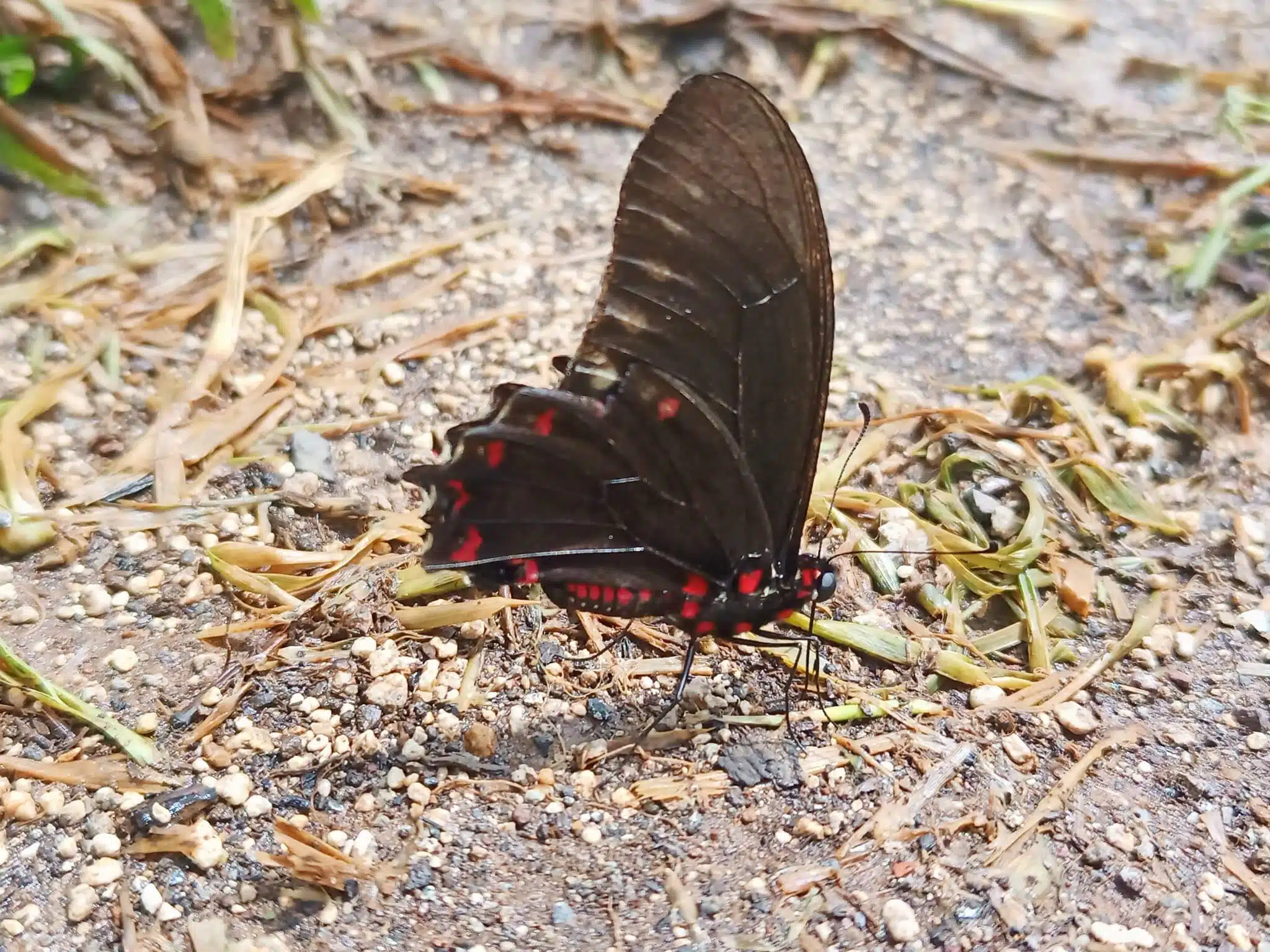
Variable Swallowtails (Mimoides phaon) have a black main color followed by white and red sections.
Its forewings are mostly black, as are its hindwings. However, the margins of the forewings and the hindwings show white marks.
Red marks are seen on the lower hindwings, closer to the body.
The lower side of the hindwings is also marked by 2 rows of white spots instead of 1 row as on the forewings.
This species feeds on Annona which is a type of sugary apple common to tropical regions of the world.
As a result, the Variable Swallowtails are mostly common in countries such as Mexico or Ecuador.
7. Doris Longwing
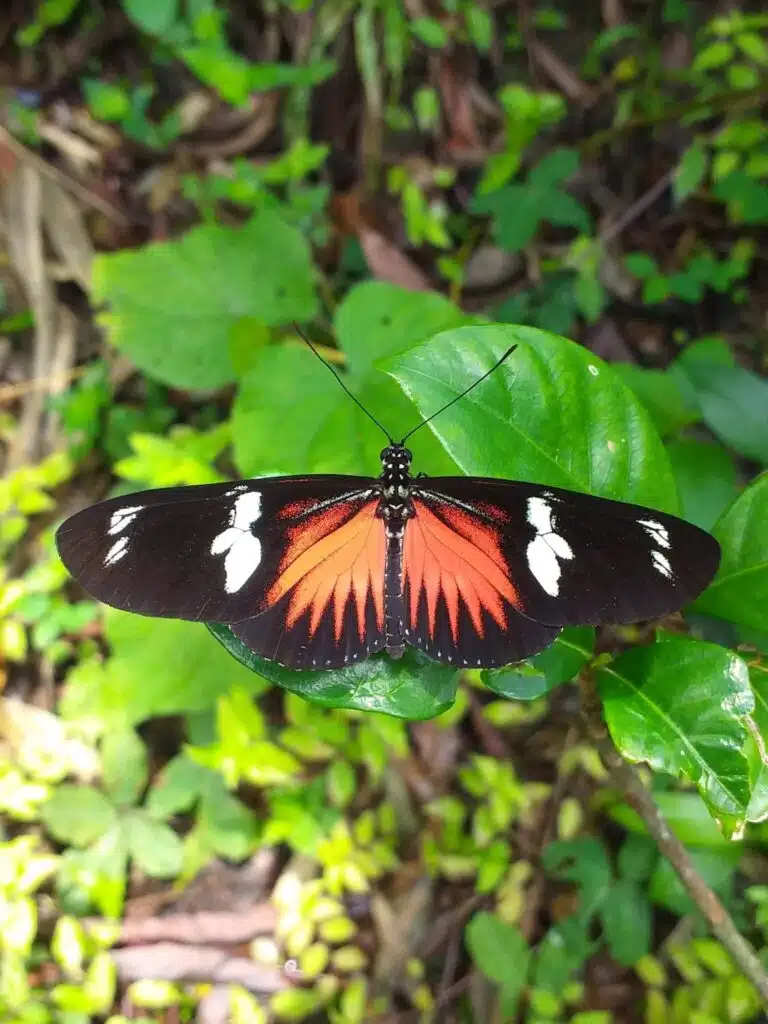
Doris Longwings (Heliconius doris) are found in a black, red, and white color across tropical realms and in South America.
The species has a black base color across all of its morphs.
Red sections dominate the hindwings together with small white dots as margins.
Dual white bands are distinguished on their forewings. This species also comes in a black, blue, and white morph.
Doris Longwing is a species that mimics other butterflies and that other butterflies mimic as well. This interdependent behavior is specific to species that want to borrow defensive mechanisms between them.
Doris Longwing butterflies have a foul taste toward predators.
8. Pink-spotted Swallowtail
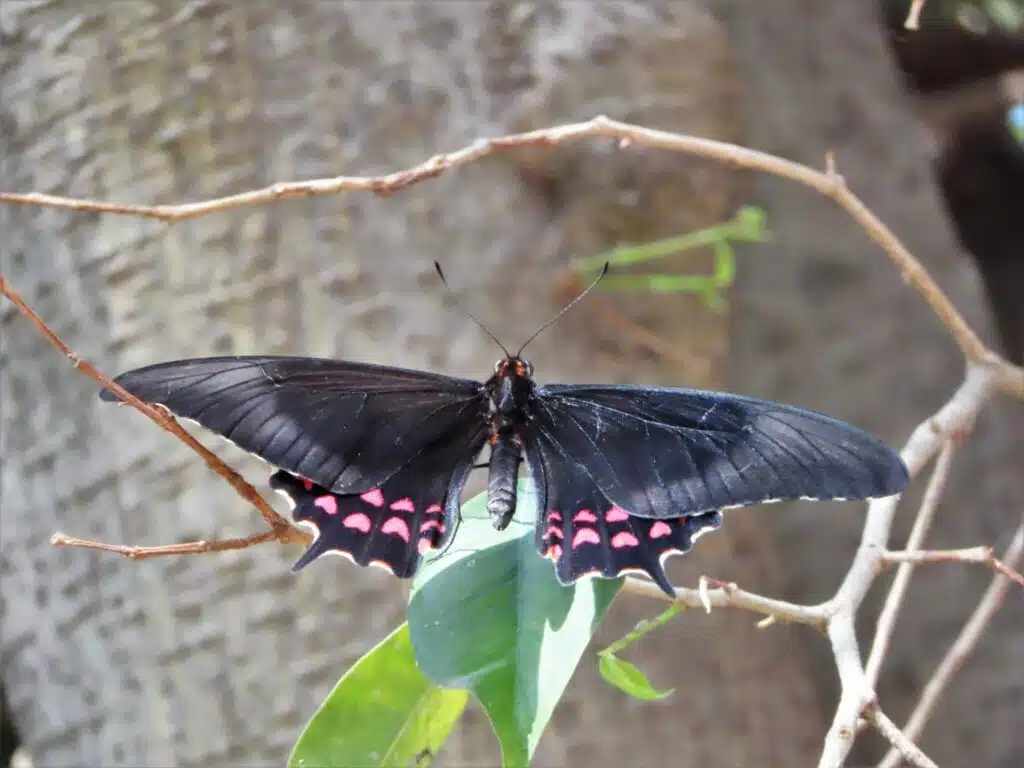
Pink-spotted Swallowtails (Papilio rogeri) are black butterflies with pink-red spots.
The forewings of the species are completely black. Hindwings have a black base color with a few rows of pink to red spots and tail-like margins that are also black.
Pink-spotted Swallowtails are some of the largest black butterflies reported in the US.
This species can reach a wingspan of up to 95mm. It only lives in the extreme South of Texas within the US.
Butterflies of this genus feed on various flowers of the citrus family. Rue flowers are among its favorites for nectar.
9. Red Peacock
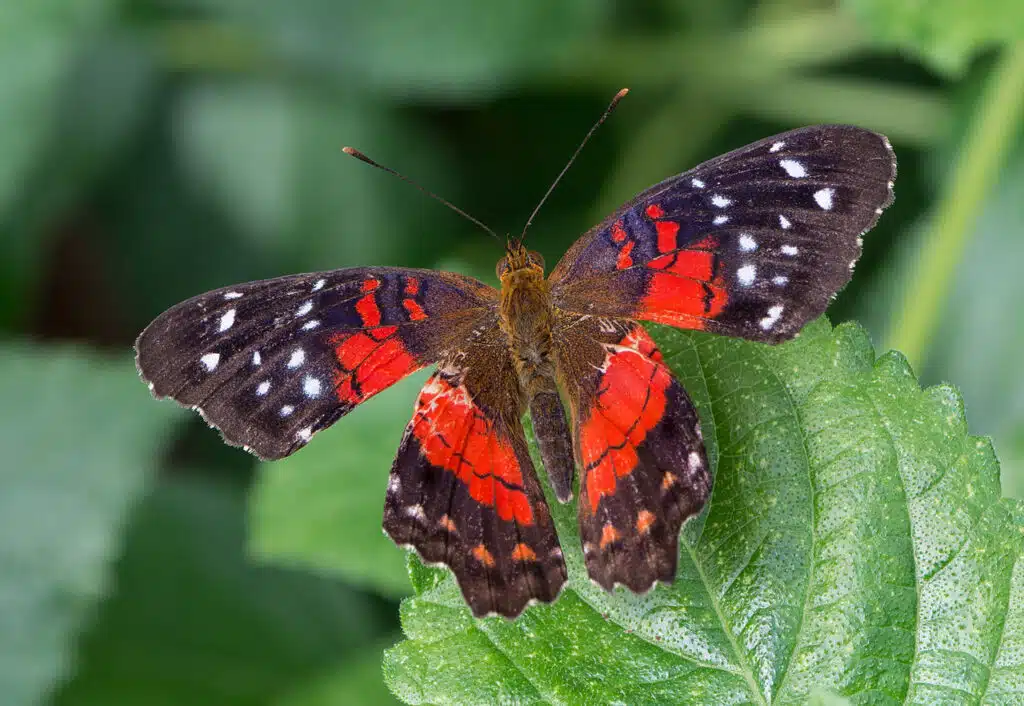
Red Peacocks (Anartia amathea) are mostly found in South America. This species has been reported in North America, but only on rare occasions.
These large colorful butterflies are seen around various tropical herbs and flowers. Sage is among them.
You can identify Red Peacocks by their bright red coloring with black wings.
Red is specific to the central areas of the wings closer to the body. Black coloring is seen across the margins.
Small white dots decorate the upper margins while red dots are seen on the hindwing margins.
The body of the species has a red-brown color.
The ventral coloring of the species is similar between the forewings and the hindwings. Brown is the main color of its ventral wings.
10. New Zealand Red Admiral
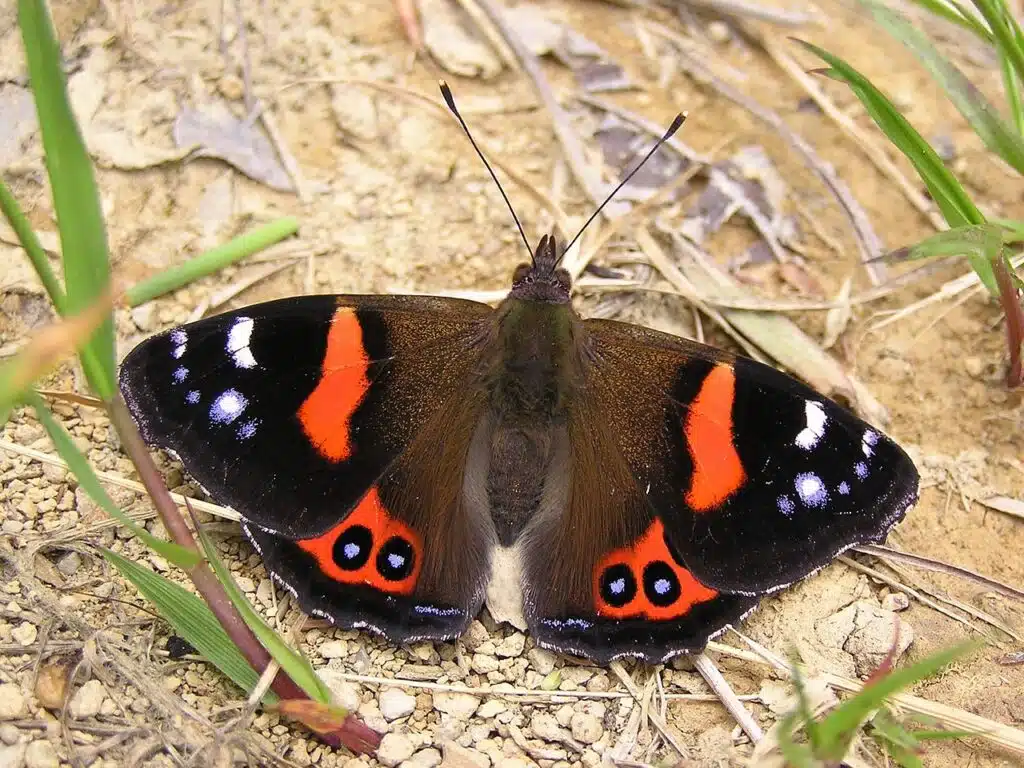
New Zealand Red Admiral butterflies (Vanessa gonerilla) 1are medium-sized species. They have a wingspan that can grow to 50mm.
Butterflies of this Admiral family are known for having brown camouflage ventral coloring of the wings.
They also show eyespots on one side of the ventral wings.
Black and red dominate its dorsal wings. The black wings have red margins.
White marks are further distinguished on the upper side of the forewings.
The species also tend to exhibit brown to black coloring closer to the body and pure black coloring further out towards the margins of the wings.
11. Crimson Rose
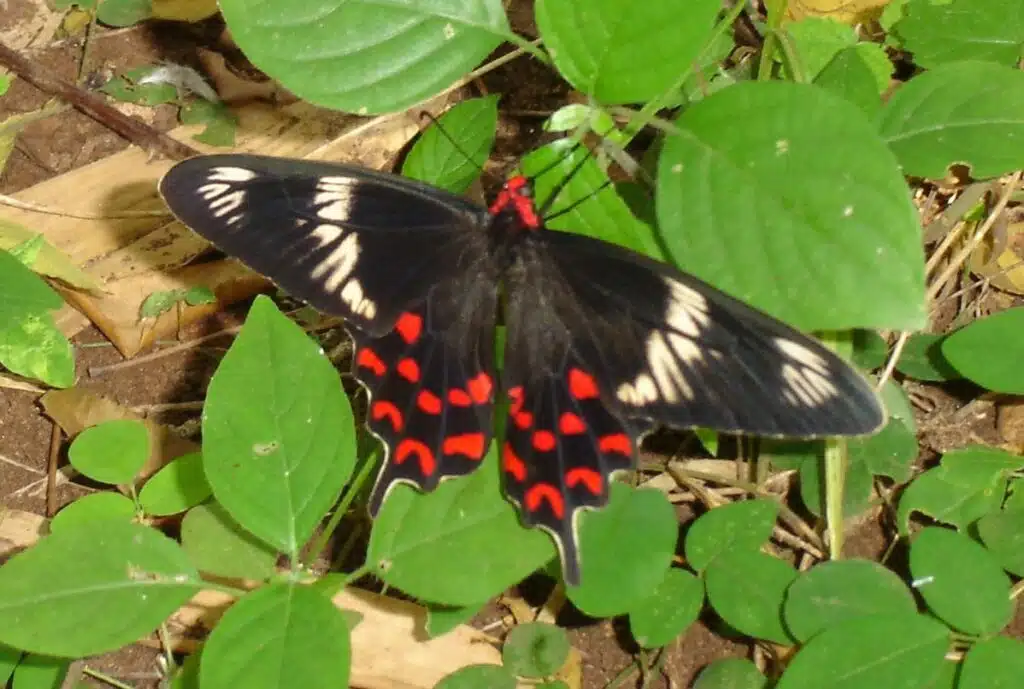
Highly common in India and other parts of Southeast Asia, the Crimson Rose (Pachliopta hector) is one of the larger black and red butterflies in the region.
This species has a main black color that dominates its body and its wings.
White bands are further distinguished on its wings while red marks are seen across its hindwings.
This species also has black tail-like hindwings.
Crimson Rose butterflies are known to live on various pipevines as caterpillars. They absorb the toxins from their host plants at an early stage in their lives for protection.
Adult butterflies of this genus have bad taste and predators stay away from them.
Crimson Rose butterflies can be found at low elevations throughout the year and high elevations in the rainy season.
12. Imperial Jezebel
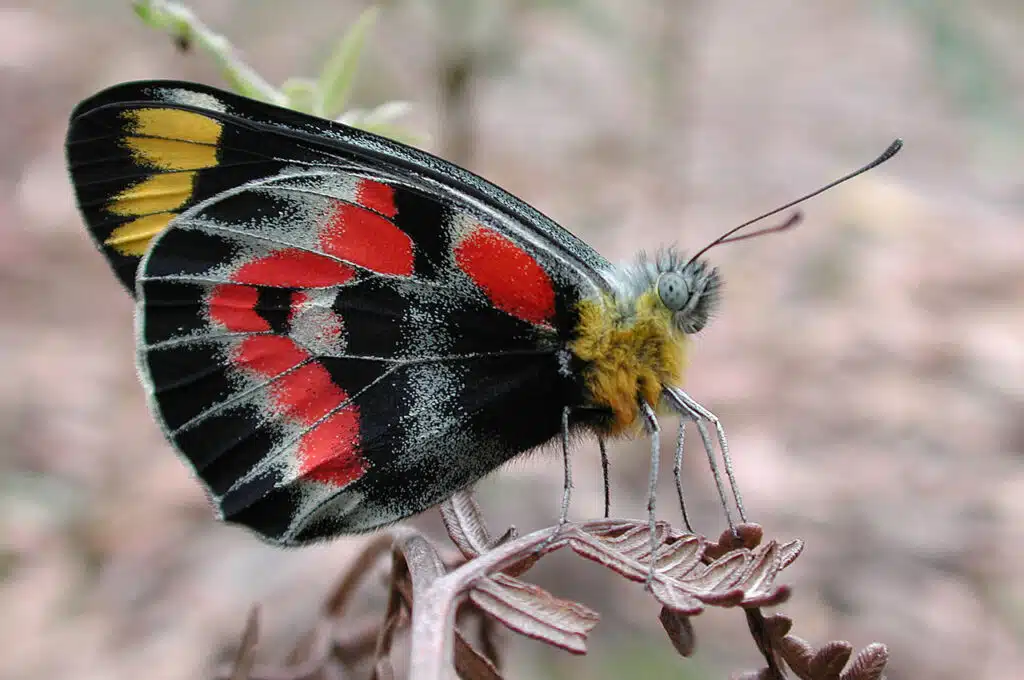
Imperial Jezebels (Delias harpalyce) are native to Australia.
They only live in areas rich in eucalypt and are known for having black and red colors on the ventral wings.
Dorsal wings are white and black on the species. White dominates the dorsal wings with black margins all across.
Black is seen on the ventral wings which also show red and black spots.
Yellow marks are also seen on the ventral side of the wings.
The species has a medium to large size as Imperial Jezebels grow to form a size of 60mm up to a size of 70mm.
13. Natal Acraea
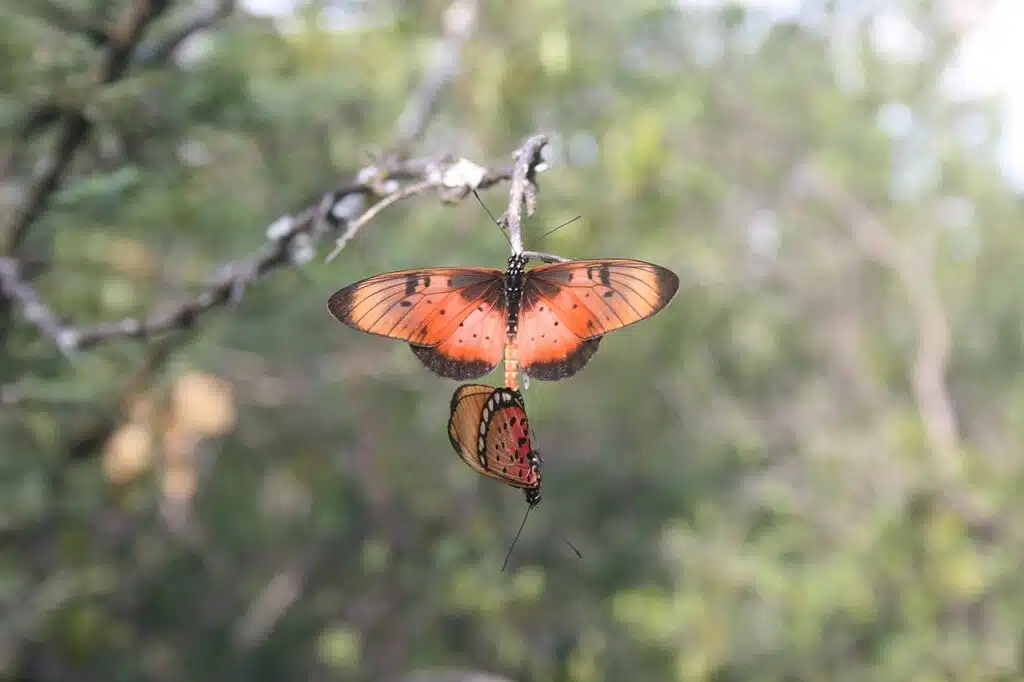
Natal Acraea butterflies (Acraea natalica) are only found in Africa. Zimbabwe is among the countries where the butterfly lives in high numbers.
Natal Acraea species are commonly found on passiflora shrubs.
You can identify the species by its red to yellow base color.
Its wings have red nuances with a yellow gradient. The upper wings are red to yellow with brown sections close to the body and on the edges of the wings.
Its hindwings are also red to yellow with brown margins. The body of the species is mostly brown to black.
14. Pink-spotted Cattleheart
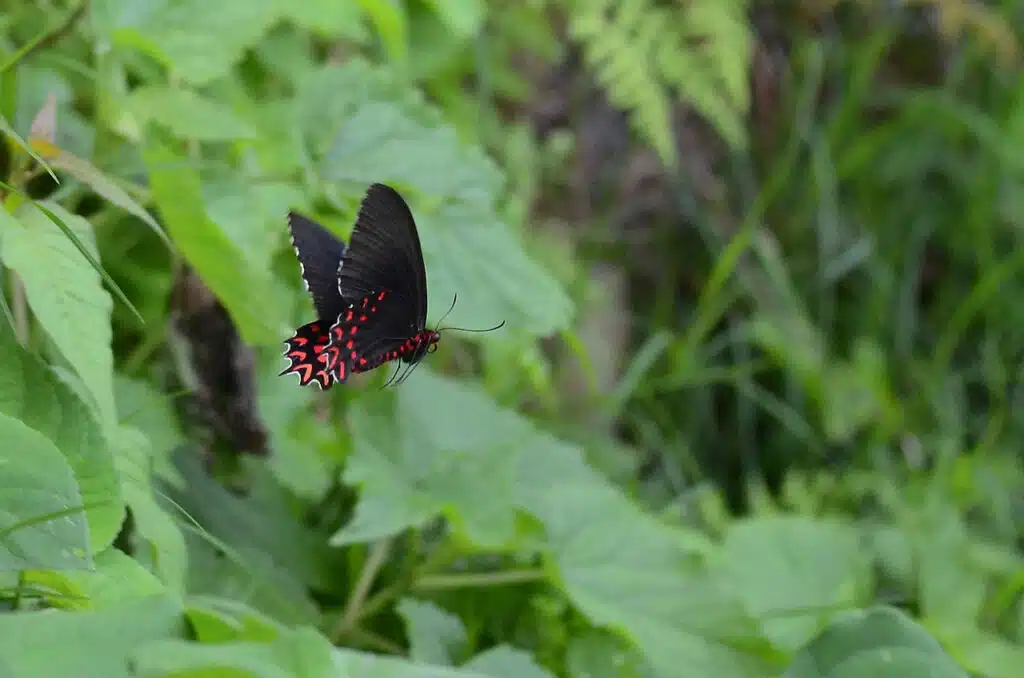
Pink-spotted Cattleheart (Parides photinus) is some of the most common black and red butterflies that have similar dorsal and ventral coloring.
These butterflies have black upper wings with black hindwings that also have red spots across.
Its hindwings are also partially white.
Similar black base colors with red spots are seen across the ventral side of its wings.
Pink-spotted Cattleheart butterflies are found across Central America the most. It’s here they can live even at a high elevation of up to a few thousand feet.
15. Cloud-forest King
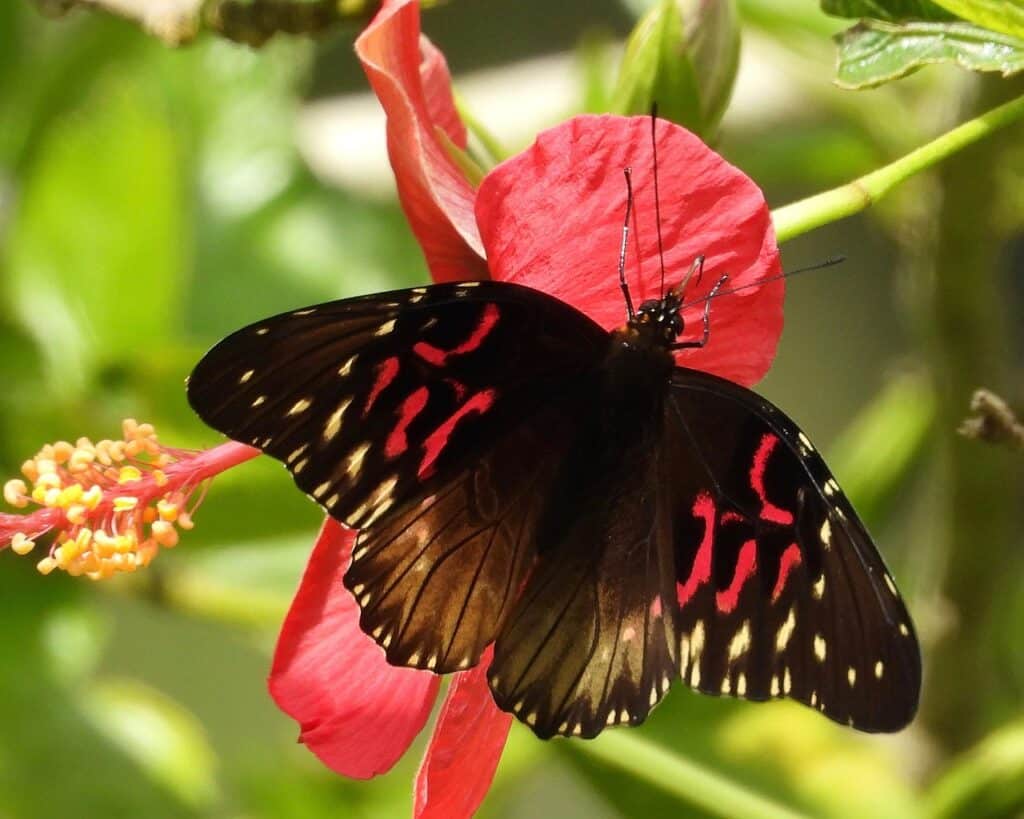
Cloud-forest King butterflies (Anetia thirza) are black species native to Central America. They live in Mexico in high numbers as well as in other countries such as Panama.
This species is colorful despite its mostly black wings.
Its upper wings are mostly black. The hindwings and the margins of the upper wings are brown.
Red marks are seen on the black areas of the forewings.
Yellow spots decorate the hindwings and the margins of the hindwings.
Dark brown colors are also specific to the hindwings. Dark brown veins are visible on this multicolored species.
16. White-dotted Cattleheart
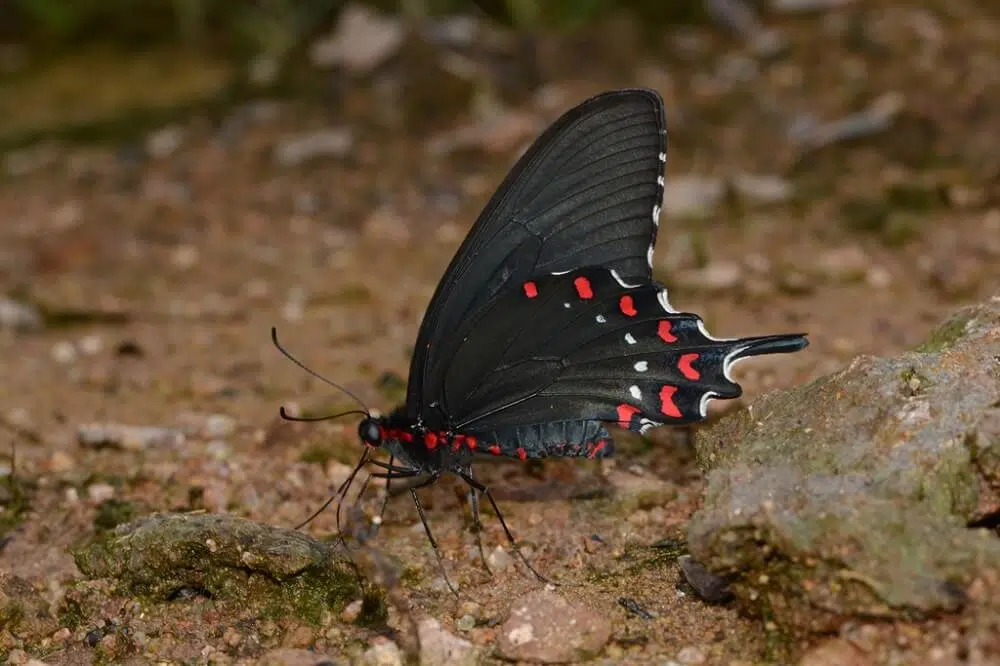
White-dotted Cattleheart butterflies (Parides alopius) have white, pink, and red dots.
Pink and white dots are specific to their dorsal wings while red dots are seen on their ventral wings and the ventral side of the body.
This species mostly lives in Central America with a reduced presence in Arizona.
White-dotted Cattleheart butterflies live in woodlands. Pine woodlands are among the favorites of the species.
You can find this black butterfly with white, pink is red dots flying in pine woodlands from May to November.
17. True Cattleheart
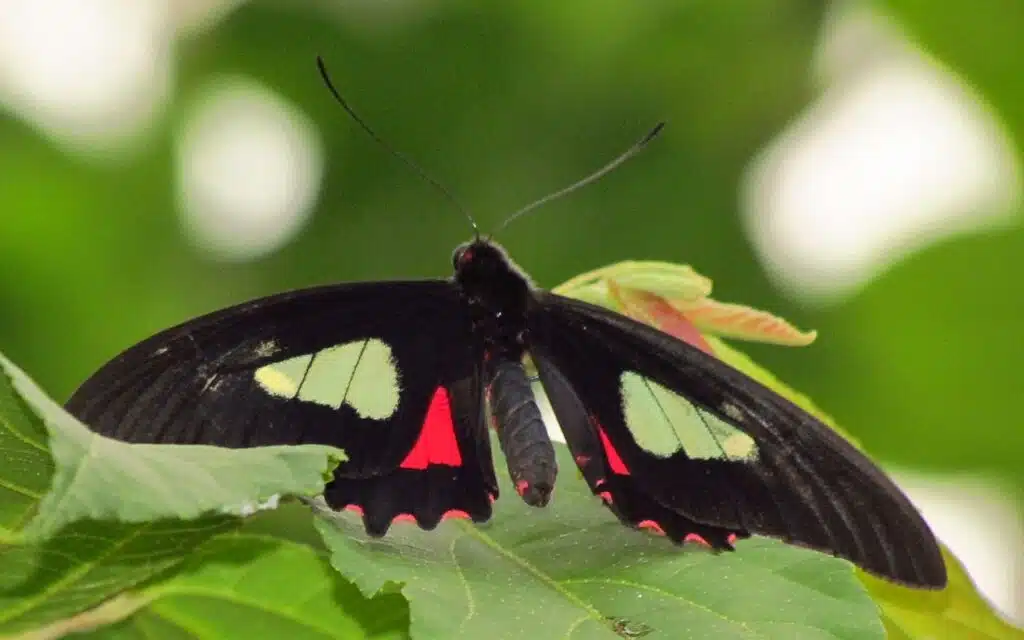
True Cattleheart butterflies (Parides eurimedes) are native to North, Central, and South America. This species has a long wingspan of up to 3.3 inches.
Butterflies of this genus are mostly black, with white, red, and pink coloring.
Unlike the White-dotted Cattleheart, the True Cattleheart has red dots on the dorsal wings and pink dots on the ventral wings.
White sections are specific to the central area of the forewings. Red sections are seen across the hindwings while the body is mostly black.
Highly common in South America, this species is seen on various flowering plants such as pelican flowers.
18. Reddish Mapwing
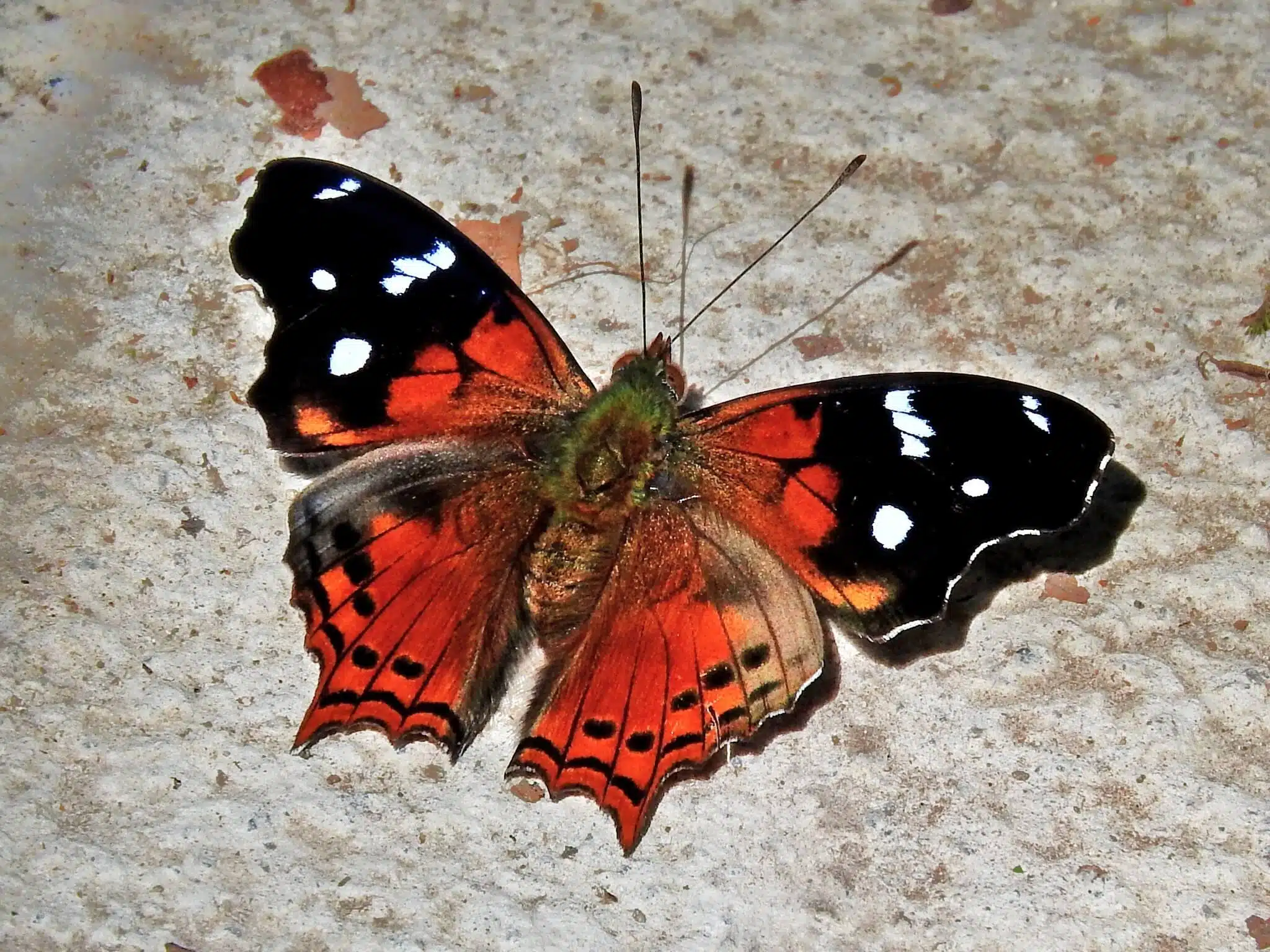
Reddish Mapwing butterflies (Hypanartia trimaculata) are native to Central and South America.
This species has red and black coloring as well as yellow and brown coloring depending on its morph.
Red wings are specific to this species. Its forewings are partially black while the hindwings are red.
Black dots are seen across its margins while white dots are visible across the black sections of the forewings.
Its body is mostly brown to gray.
19. Small Flambeau
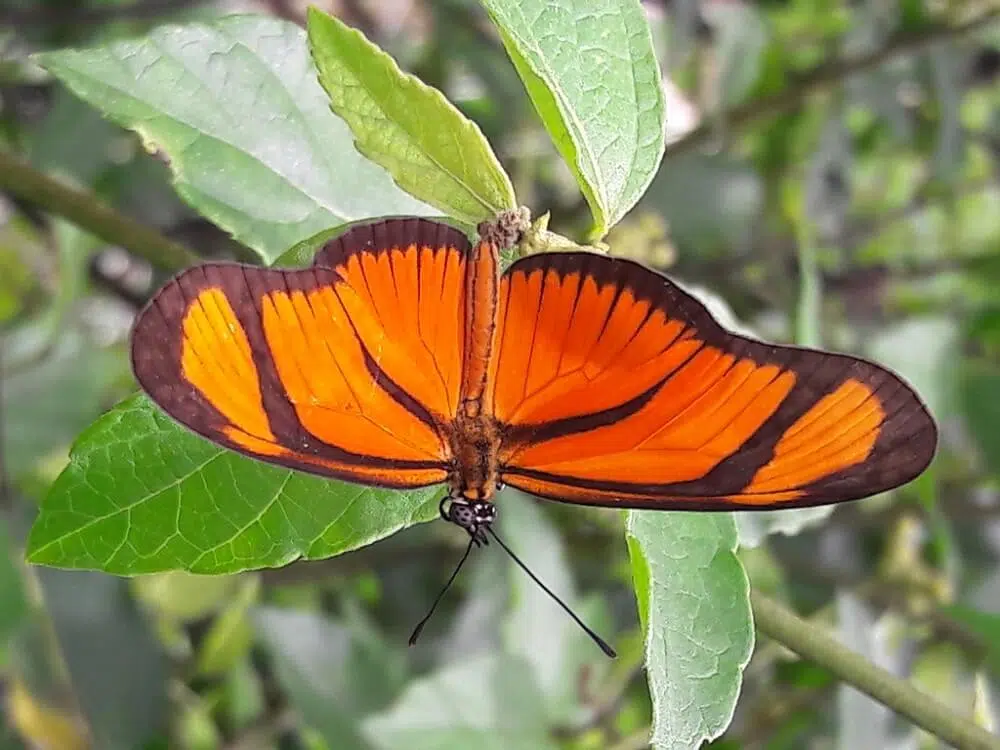
Small Flambeau butterflies (Eueides aliphera) are native to Central and South America.
This species has red and black coloring on the dorsal wings and orange and black coloring on the ventral wings.
Red dominates the coloring of its wings with black margins and a few black bands across. Its body is mostly orange-brown.
Orange and black coloring is specific to the ventral side of the species. The patterns of black margins and black diagonal bands are visible across all of the morphs of the species.
Common across Mexico, Small Flambeau butterflies are found at different elevations. These butterflies can be seen at elevations of up to 5.000 feet.
20. Costa-spotted Beautymark
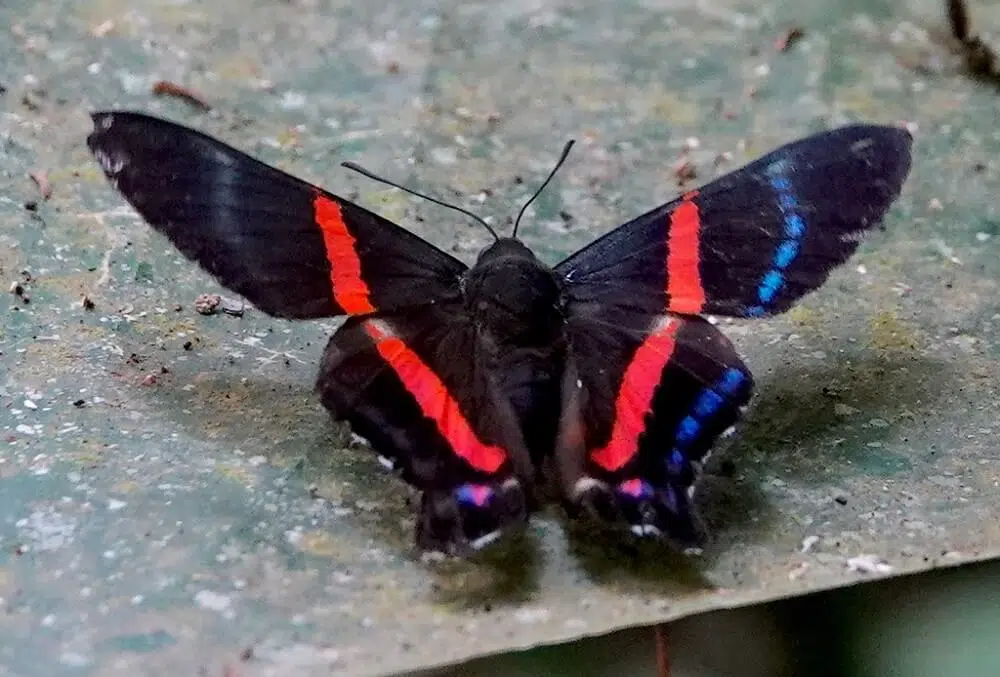
Native to Europe, this large butterfly (Ancyluris jurgensenii) comes is mostly black but subtle differences are seen between males and females.
Male Costa-spotted Beautymark butterflies are mostly black. They have black forewings and black hindwings. This species also has red vertical bands across the forewings and hindwings.
Blue coloring is seen on the lower hindwings and along the margins.
Females have similar coloring but without blue marks. They have black wings with red vertical bands and small white marks across the margins of the hindwings.
The ventral side of the species is also black and white with wide vertical bands.
21. Banded Lady
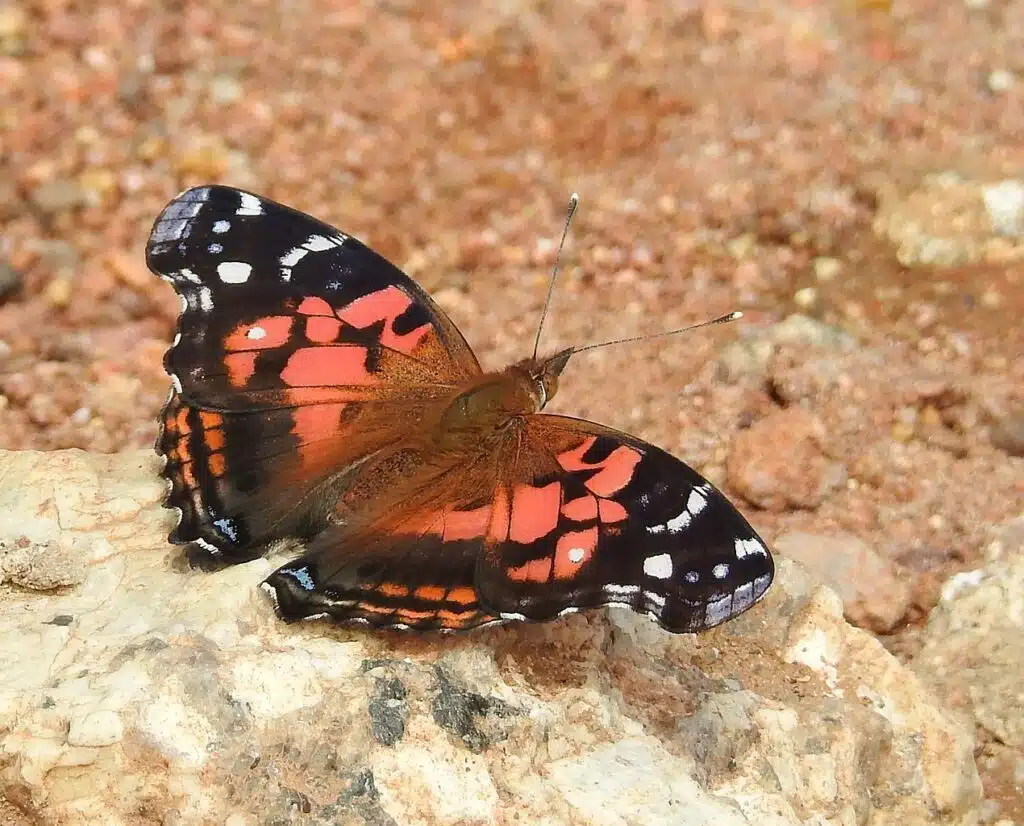
Banded Lady butterflies (Vanessa myrinna) are a black and red species that also have eyespots.
This species has the red base coloring of the dorsal wings. Black is the color of the wings further out to the margins.
Black spots and patterns are also seen across the wings. The body of the species is mostly brown.
Singular white eyespots are seen on the margins of the upper wings.
The ventral side of the species has brown coloring with gray and white bands. The veins on the ventral side of the wings are also white.
Large blue eyespots are further distinguished on the ventral wings.
These eyespots aim to distract predators or to make them attack less important parts of the wings such as the margins first.
22. Anchises Cattleheart
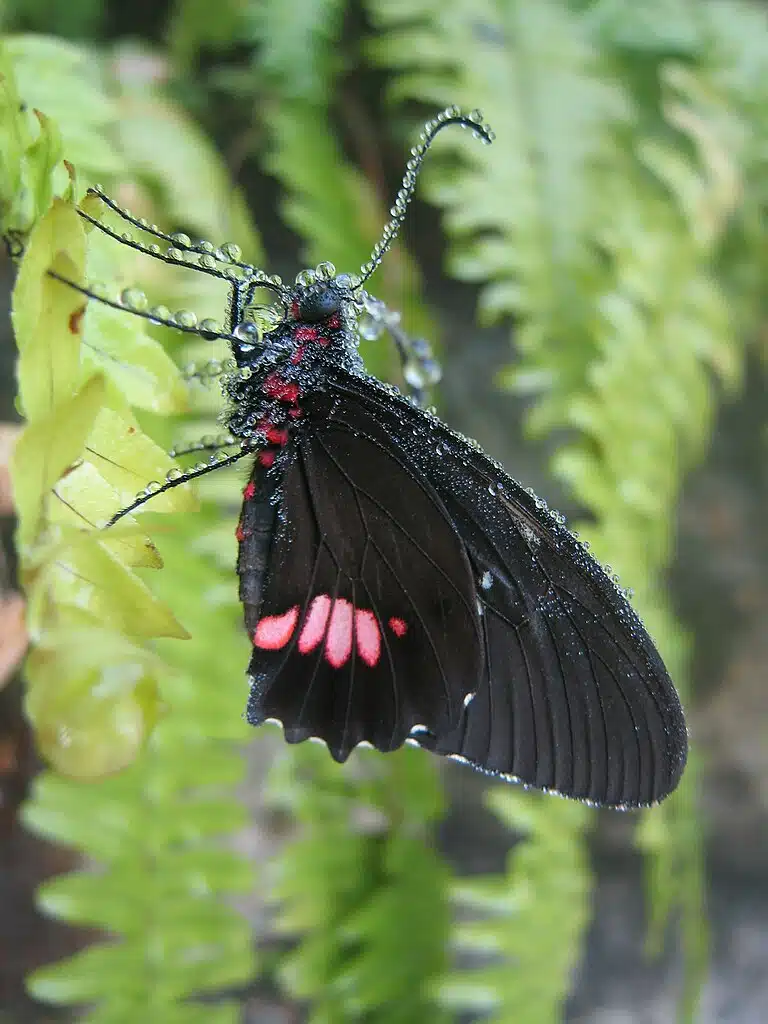
Anchises Cattlehear butterflies (Parides anchises) are native to North America.
The species feeds on multiple flowering plants, all part of the pipevine family.
Anchises Cattleheart butterflies have mostly black coloring. The upper and lower wings also show colorful central patches.
The forewings of these butterflies are black. They have white and gray central sections.
Black hindwings are also visible on the species. Red central sections are specific to the hindwings.
Some morphs of the species show pink coloring instead of red coloring on the hindwings.
Brown is the main color of the ventral wings of the species.
Its ventral wings always show colorful patches on the hindwings and sometimes show colorful patches on the central forewings.
Brown, pink, or white central patches are seen in the center of the ventral wings.
23. Flamingo Leafwing
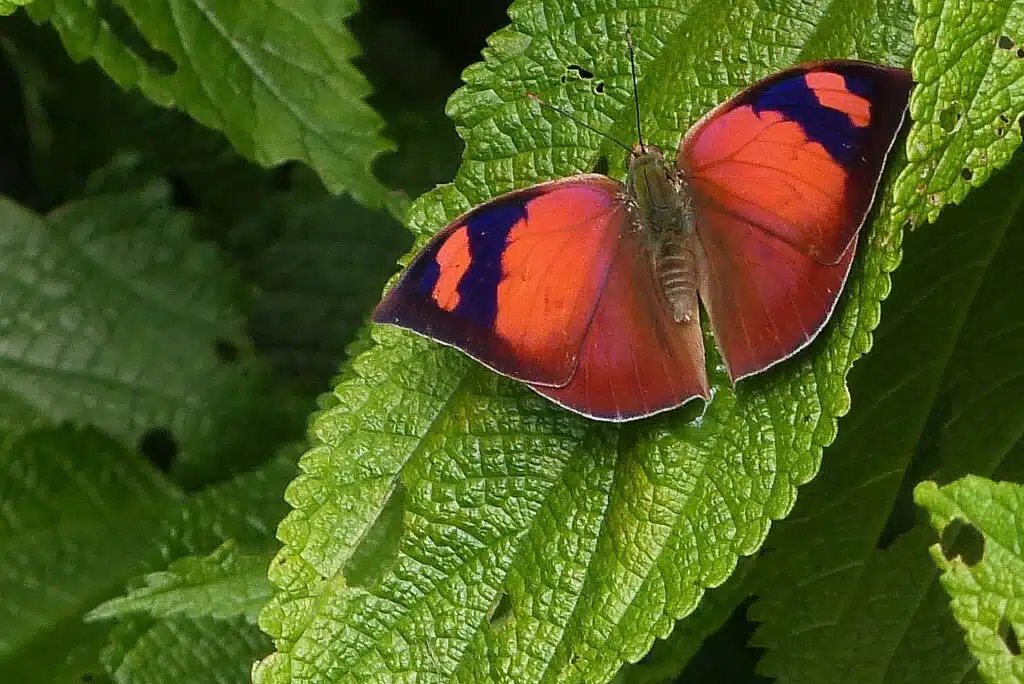
Flamingo Leafwing butterflies (Fountainea ryphea) are native to Central and South America. They are present in space from Mexico to Brazil.
These large butterflies have red, black, and brown coloring.
Their wings are mostly red. Black margins are specific to the species.
Slight nuances are further distinguished for the species when it comes to red nuances. Brighter red colors are seen on the forewings while the hindwings are darker red.
The body of the species appears brown to light brown.
Riparian zones or areas of dense vegetation around water are the preferred habitats for the species.
These butterflies spend most days sitting on their host plants next to rivers and lakes.
24. Pink-banded Sister
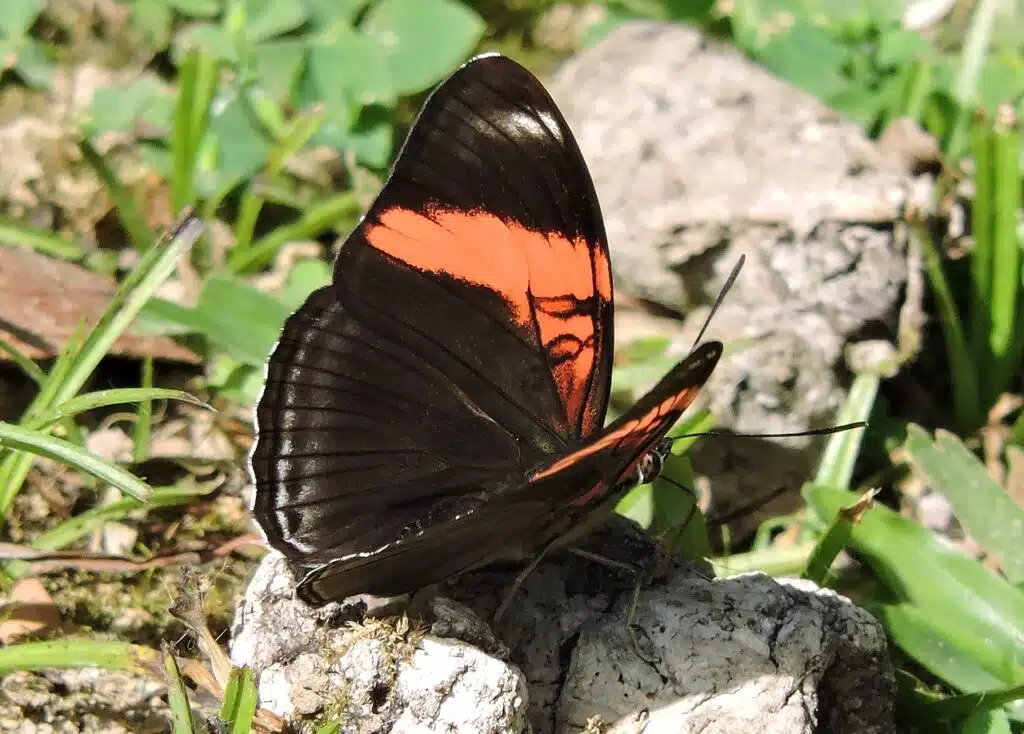
Pink-banded Sister butterflies (Adelpha lycorias) get their name from the wide pink diagonal bands across their forewings.
These butterflies have a maroon ventral color and black dorsal wings.
The wings of the species are mostly black.
Red banding is specific to the forewings of the species. These large red bands are bordered by small red spots.
Pink-banded Sister butterflies grow to a wingspan of up to 2 inches.
The natural habitat of the species is expansive. To the North, the species is found up to Mexico. Southern limits of its distribution are Ecuador and Bolivia.
The limits of the species are limits of various nettle plants to which they might even migrate for.
Various species of nettle host Pink-banded Sister caterpillars.
Jamaican nettle and urera are the most common host types of nettle.
25. Aulestes Doctor
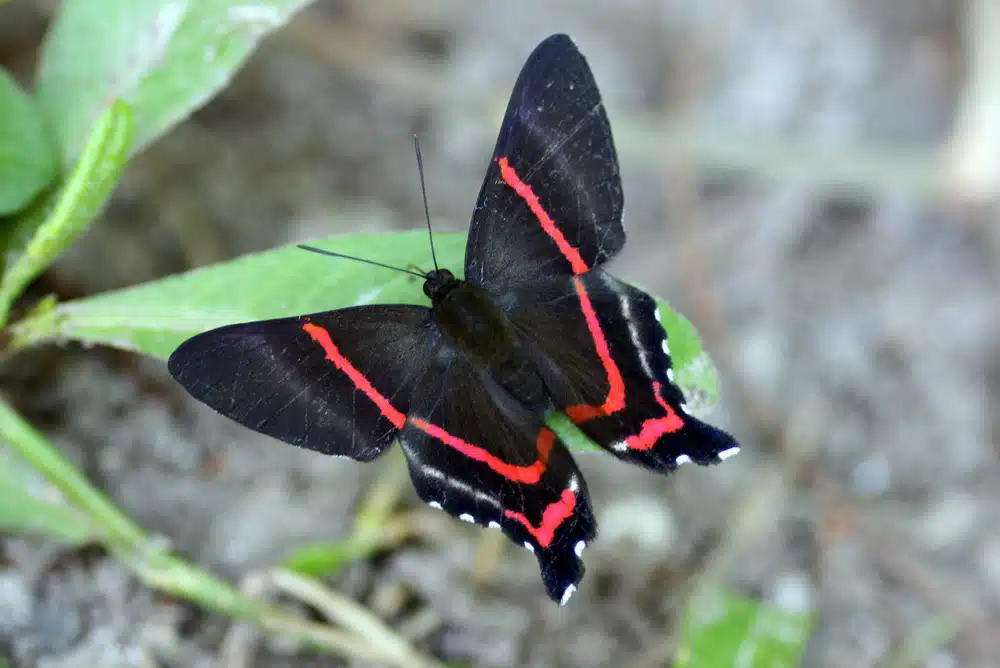
Aulestes Doctor butterflies (Ancyluris aulestes) have a base black color and further differentiations between males and females.
The species has black forewings and black hindwings. Blue spots with white central marks are seen across its forewings.
Double red bands decorate its hindwings together with half-moon white marks on the margins.
Females of the species lack blue sections on the wing. Black is still the main color of the females with orange bands as decoration.
Further morphs of the species also show combinations of colors for banding.
These butterflies can have left red bands across the forewing and the hindwing and yellow bands across the forewing and the hindwing.
Ventral color can sometimes be identical to dorsal coloring.
26. Red-barred Amarynthis
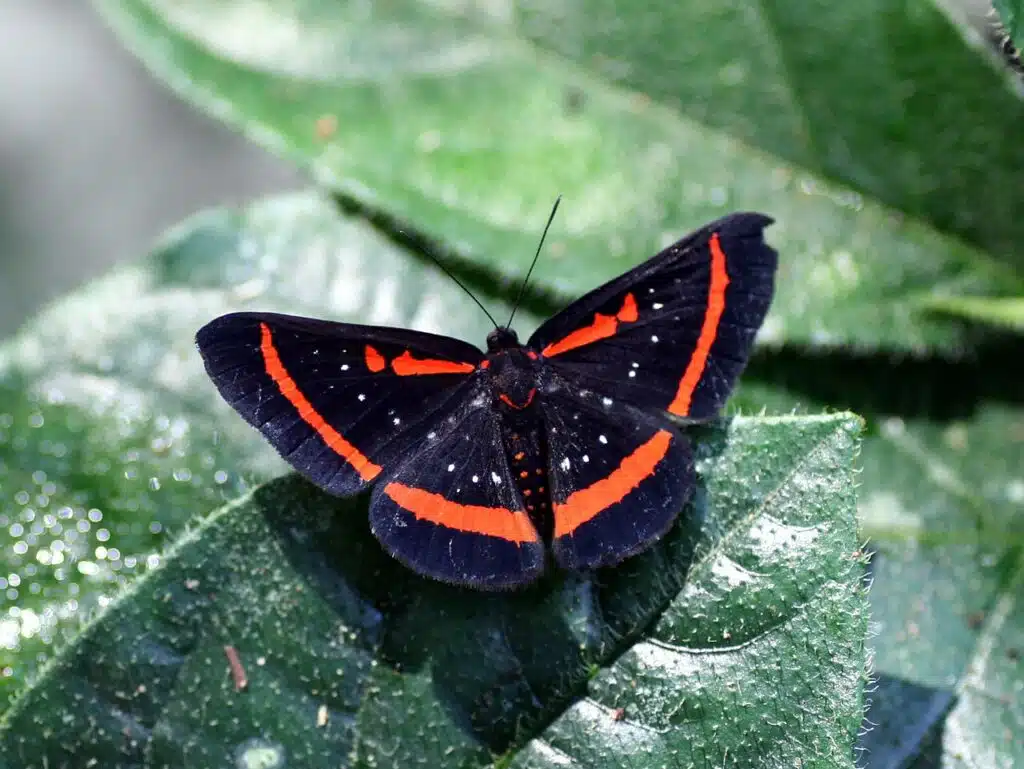
Red-barred Amarynthis butterflies (Amarynthis meneria) are native to Central and South America.
Most of the butterflies of the species live in lowland rainforests and areas close to water, particularly in forests.
Red-barred Amarynthis butterflies have mostly black coloring. The forewings and the hindwings are mostly black.
Red bands follow the outer edges of the wings. Some red spots and dots are also seen on 2 rows across the body.
Unlike other black and red butterflies, Red-barred Amarynthis also show tiny celestial-style white dots on the wings, particularly on the central areas of the wings.
The species has growing habitat across South America. It’s found East of The Andes in countries such as Surinam.
27. Red Flasher
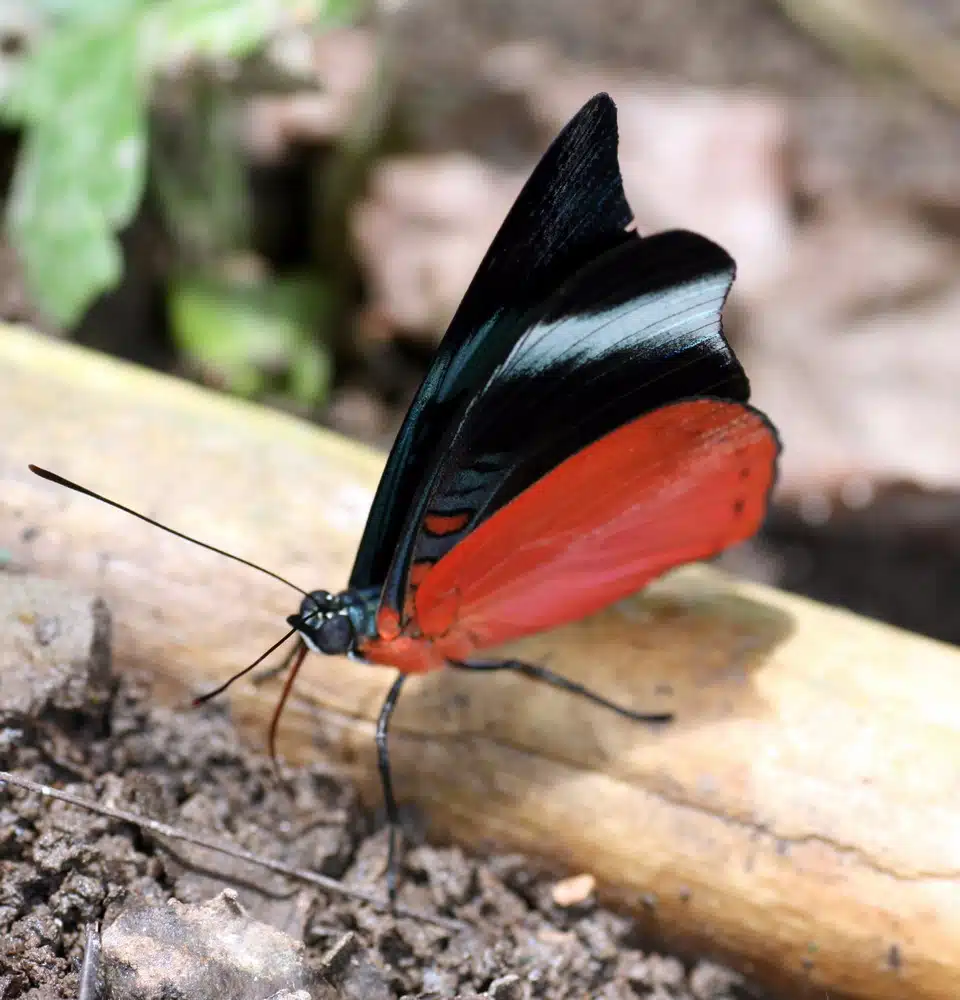
Red Flasher butterflies (Panacea prola) are some of the most colorful black and red butterflies.
The dorsal coloring of the species is mostly black with different blue nuances.
Its ventral wings are mostly black, blue, and red.
Black and blue nuances are seen across its forewings. Small red dots are further visible on the inner side of its forewings.
The hindwings have a bright red color with tiny black spots across the margins.
Red Flashers are a medium to larger species of black and red butterflies. Their minimum wingspan is 65mm while the largest members of the species have a wingspan of up to 75mm.
The species is mostly found in South America and Central America.
The highest populations of Red Flasher butterflies are found in Peru.
28. Cramer’s Mesene
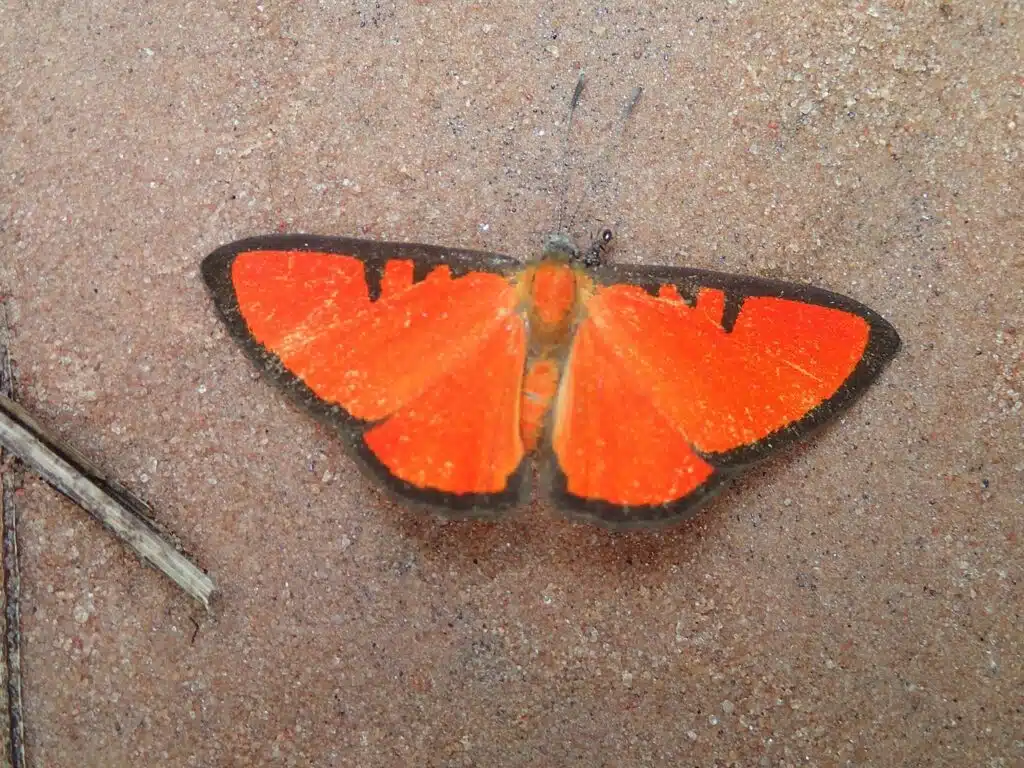
Cramer’s Mesene butterflies (Mesene phareus) are a common species of red and black butterflies in Central and South America.
This species is native and present in high numbers in countries such as Suriname.
You can identify the butterflies by a base bright red color. The wings have wide black margins across.
Growing to a wingspan of up to 2 inches, Cramer’s Mesene butterflies have orange ventral wings with black margins.
Small color variations exist between the morphs of the species.
One Cramer’s Mesene butterfly morph has red wings with brown margins and brown upper forewings.
Other morphs of this widespread butterfly only come in brown and orange colors.
29. Redline Doctor
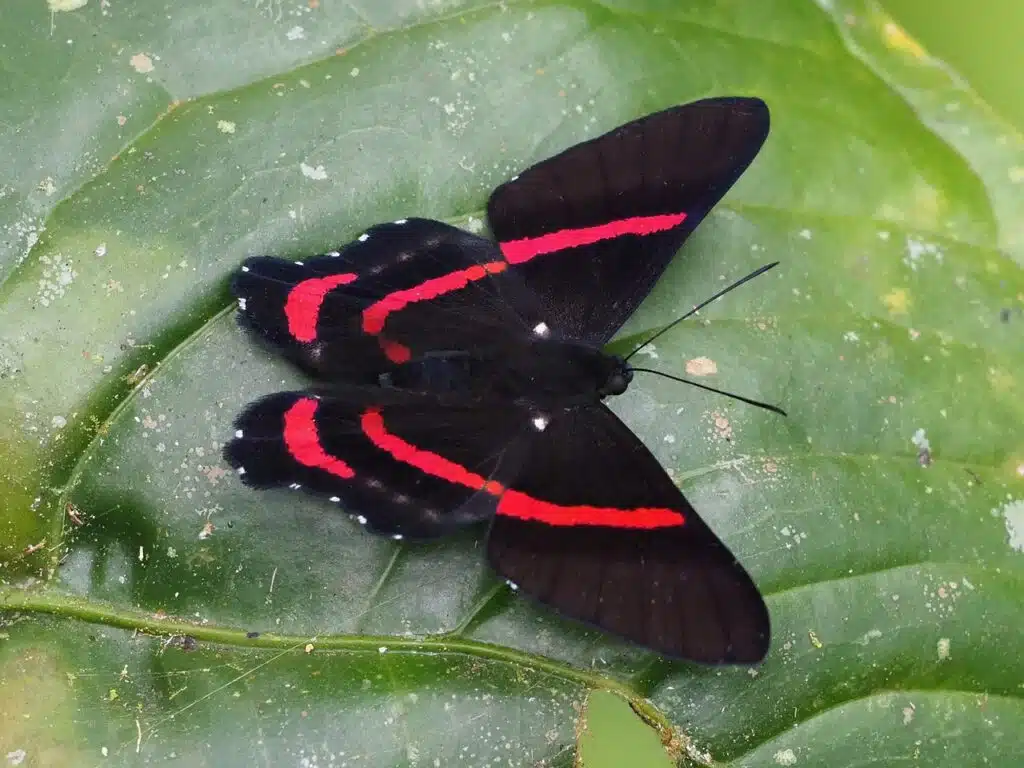
Redline Doctors (Ancyluris meliboeus) are mostly black and red butterflies bound in South America.
The species has black forewings and black hindwings. Red bands are seen across the forewings with double red bands being specific to the hindwings.
Small white spots are seen across the margins of the lower wings.
Black, blue and red colors are specific to the ventral side of its wings. The wings are mostly black with blue and red sections on the hindwings.
This species is also known for cannibalistic behavior within its species. The larvae of Redline Doctors can eat other larvae when going hungry.
Male Redline Doctors are further known for puddling, a behavior where they extract moisture and nutrients from mud.
30. Fiery Satyr
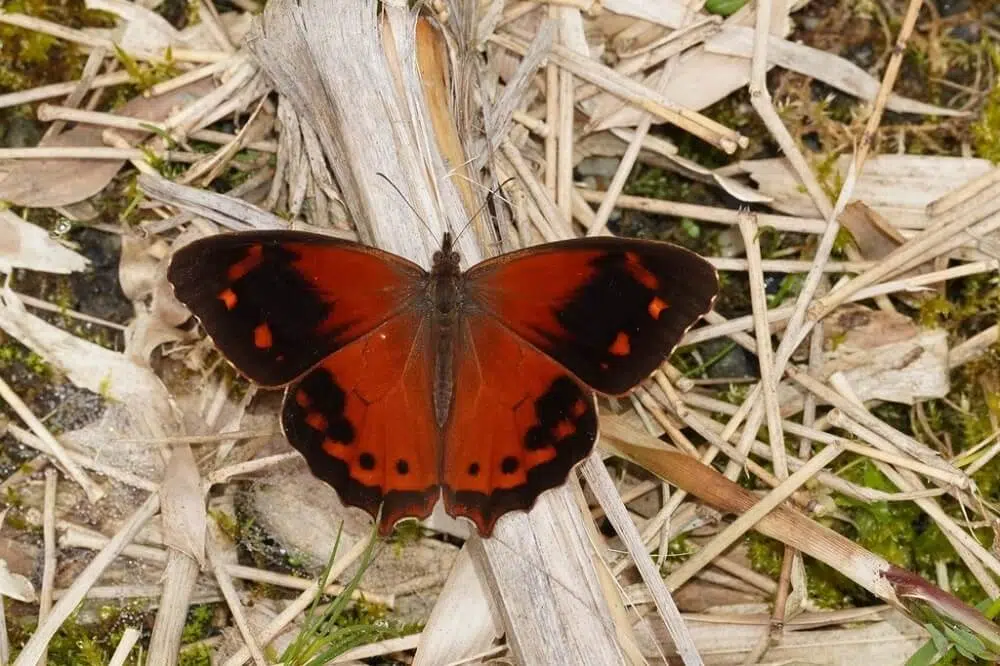
Fiery Satyr butterflies (Lasiophila orbifera) have an orange-red base color. Black sections of its wings make its bright color even easier to spot.
The coloring of Fiery Satyr butterflies changes with time.
These butterflies first emerge with fully bright red wings. This red color starts to fade to an orange color within a few days.
Fiery Satyr has brown ventral wing colors which maintain their nuance over time, unlike the dorsal colors of the wings.
Native to South America, the Fiery Satyr is a species that can be found in woodlands. It inhabits woodlands across multiple countries such as Bolivia and Argentina.